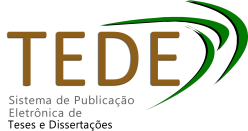| ???jsp.display-item.social.title??? |


|
Please use this identifier to cite or link to this item:
http://tede.upf.br:8080/jspui/handle/tede/922Full metadata record
| DC Field | Value | Language |
|---|---|---|
| dc.creator | Schneider, Fernanda | - |
| dc.creator.Lattes | http://lattes.cnpq.br/0363765005528268 | por |
| dc.contributor.advisor1 | Toldo, Claudia Stumpf | - |
| dc.contributor.advisor1Lattes | http://lattes.cnpq.br/7927613573357678 | por |
| dc.date.accessioned | 2018-01-10T18:09:12Z | - |
| dc.date.available | 2011-05-23 | - |
| dc.date.issued | 2011-04-01 | - |
| dc.identifier.uri | http://10.0.217.128:8080/jspui/handle/tede/922 | - |
| dc.description.resumo | Neste trabalho, propomo-nos analisar a construção do humor nas tiras de Iotti, à luz da Teoria da Enunciação de Émile Benveniste. Nosso objetivo principal é descrever e analisar como o humor é construído, baseando-nos nos conceitos propostos na teoria que norteia essa pesquisa. Tomamos como ponto de partida para tal investigação as obras de Benveniste intituladas Problemas de linguística geral I e Problemas de linguística geral II (1966 . 1974, respectivamente). Segundo a proposta aqui formulada, a enunciação é da ordem do irrepetível, do singular, manifestada a cada vez que alguém diz .eu. a um .tu. em relação a .ele.. Assentados nesse contexto teórico, desenvolvemos a argumentação em torno da ideia de que o humor é fruto de uma construção derivada da situação de enunciação, entendida a partir do que Benveniste considera enunciação: .ato de tornar fala a língua. (FLORES; TEIXEIRA, 2008, p. 42). Dessa forma, a pesquisa é descritiva, bibliográfica e qualitativa porque tem a finalidade de observar e analisar fatos linguísticos em tiras de humor. Para tanto, partimos da noção de que .a referência é parte integrante da enunciação. (BENVENISTE, 2006c, p. 84) e de que é o locutor que a estabelece no ato de discurso. Como a referência . significação singular e irrepetível da língua . não pode ser prevista nem fixada, a hipótese é a de que o humor se realiza na situação de discurso ., que é definidora da referência, por meio da relação indissociável de forma e sentido (semiótico e semântico). Para que os objetivos propostos fossem alcançados, utilizamos um corpus composto por cinco tiras de Iotti (2010), selecionadas do site oficial do autor. Após a seleção do corpus, realizamos a análise de cada tira em duas etapas: 1) descrição dos elementos textuais da tira, 2) análise enunciativa da tira, considerando a relação enunciação e humor, com base nos três elementos que, segundo Benveniste (2006c), constituem o quadro formal da enunciação: o ato de enunciação; a situação em que a enunciação se realiza e os instrumentos utilizados no uso da língua nas tiras analisadas. Posteriormente, procedemos à discussão das análises. Por meio deste estudo, percebemos que é pela relação indissociável entre forma e sentido que o humor é construído na e pela enunciação | por |
| dc.description.abstract | In this study, we propose to analyze the construction of the humor in the strips of Iotti. Our main objective is to describe and analyze how the humor is built from the study of concepts proposed in the theory that guides this research. We take as a starting point for such research, the theoretical support in the works of Benveniste entitled Problems in General Linguistics I and Problems in General Linguistics II (1966 - 1974, respectively). Under the proposal made here, the enunciation of the order is unrepeatable, singular, manifested every time someone says "I" to a "you " for "he". From this theoretical context developed an argument in favor of that humor is the result of a construction derived from the situation of enunciation, understood from what Benveniste believes enunciation of "speech act of making the language" (FLORES; TEIXEIRA, 2008, p. 42). Thus, research is descriptive and qualitative bibliography because its purpose is to observe and analyze linguistic facts in comic strips. For that, we started with the notion that "the reference is part of the enunciation (BENVENISTE, 2006c, p. 84), is the announcer states that the act of speech. Since the reference - singular and unrepeatable meaning of the language - can not be predicted or determined, the assumption is that the humor is done in the speech situation - that is defining the reference through the inseparable relationship of form and meaning (semiotic and semantic). For the proposed objectives are achieved, we used a corpus consisting of five (5) strips of Iotti (2010), selected from the official website of the author. After selecting the corpus, we conducted an analysis of each strip into two stages: 1) the textual description of the strip, 2) analyzing expository Strip, considering the relationship enunciation and mood, based on three elements that, according to Benveniste (2006c) constitute the formal framework of enunciation: the act of enunciation: the situation where the announcement is made and the instruments used in language use in the strips analyzed. Then we proceeded to discuss the analysis. Through this study, we realized that it is the inseparable relationship between form and meaning that the humor is built on/and enunciation | eng |
| dc.description.provenance | Made available in DSpace on 2018-01-10T18:09:12Z (GMT). No. of bitstreams: 1 2011FernandaSchneider.pdf: 2725668 bytes, checksum: f3d9f3910e471d9088c5feb2b09dea1d (MD5) Previous issue date: 2011-04-01 | eng |
| dc.format | application/pdf | por |
| dc.language | por | por |
| dc.publisher | por | |
| dc.publisher.department | Estudos Linguísticos e Estudos Literários | por |
| dc.publisher.country | por | |
| dc.publisher.initials | por | |
| dc.publisher.program | Programa de Pós-Graduação em Letras | por |
| dc.rights | Acesso Aberto | por |
| dc.subject | Língua portuguesa | por |
| dc.subject | Análise do discurso | por |
| dc.subject | Análise linguística | por |
| dc.subject | Histórias em quadrinhos | por |
| dc.subject | Portuguese language | eng |
| dc.subject | Discourse analysis | eng |
| dc.subject | Linguistic analysis (Linguistic) | eng |
| dc.subject | Comic books, strips, etc. | eng |
| dc.subject.cnpq | CNPQ::LINGUISTICA, LETRAS E ARTES::LETRAS::LINGUA PORTUGUESA | por |
| dc.title | Enunciação e humor : uma análise linguística de tiras | por |
| dc.type | Dissertação | por |
| Appears in Collections: | Programa de Pós-Graduação em Letras | |
Files in This Item:
| File | Size | Format | |
|---|---|---|---|
| 2011FernandaSchneider.pdf | 2.66 MB | Adobe PDF | View/Open ???org.dspace.app.webui.jsptag.ItemTag.preview??? |
Items in TEDE are protected by copyright, with all rights reserved, unless otherwise indicated.




